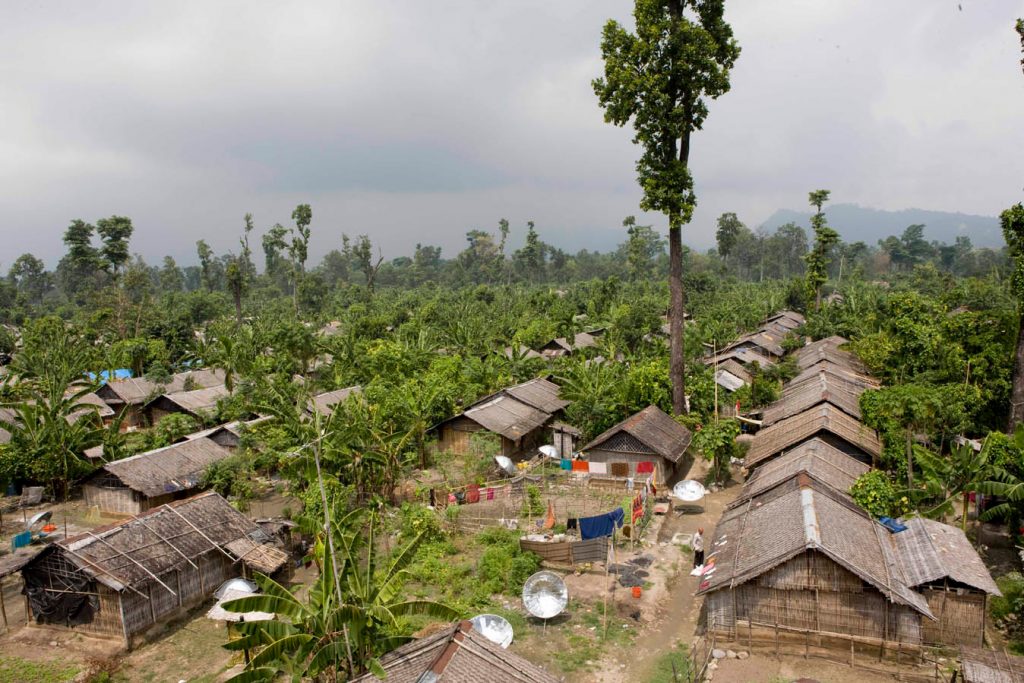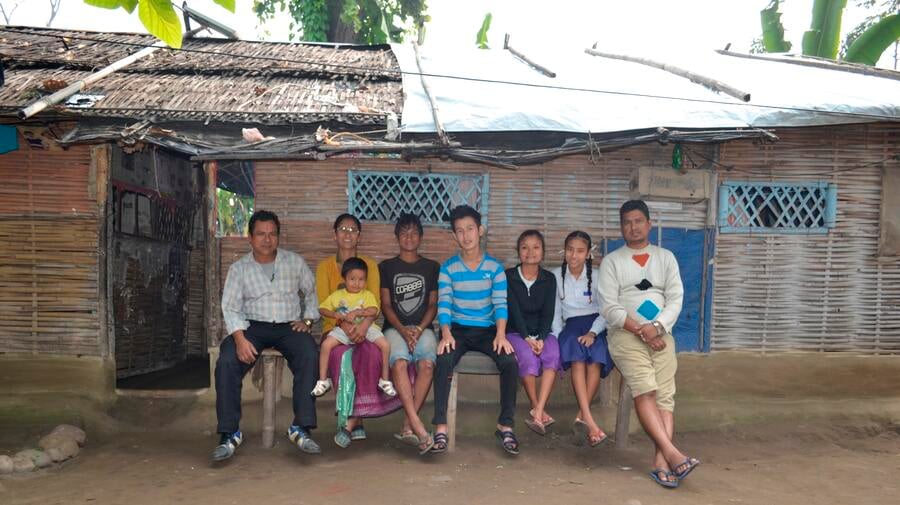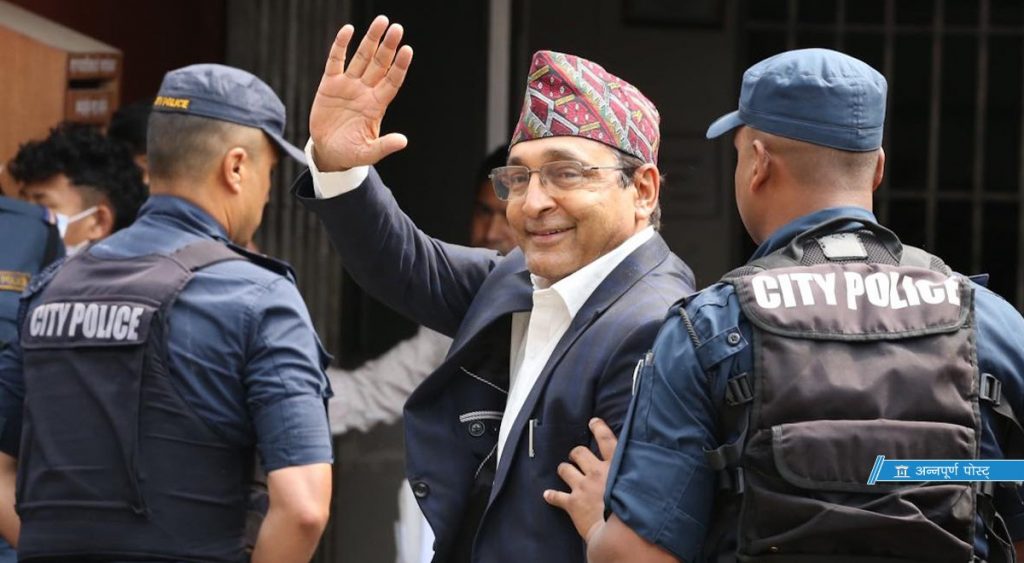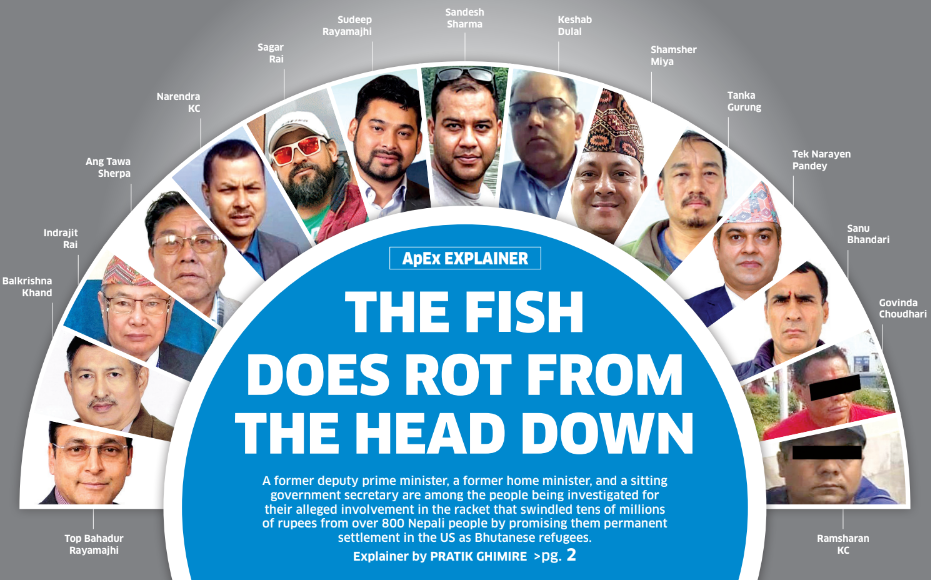The fake Bhutanese refugee scam has rocked the country. Police have arrested 15 individuals so far, including a former deputy prime minister, a former home minister, and a sitting government secretary, for their alleged involvement in a racket that swindled tens of millions of rupees from hundreds of Nepali people by promising them resettlement in the US as Bhutanese refugees. The police plan to charge-sheet them under organized crime, while many are demanding that they be charged with treason. The racket was involved in forging the name list of Bhutanese refugees awaiting resettlement prepared by a task force formed by the Home Ministry.
Here is a simple guide to understanding the scandal that has disgraced Nepal’s government institutions, politicians and bureaucrats.
The beginning of Bhutanese refugee problem
The Bhutanese refugee crisis began in the early 1990s when tens of thousands of Nepali-speaking Bhutanese people (Lhotshampas) were driven away by the Bhutanese government from their homeland. Discriminatory policies and human rights violations targeting the Lhotshampas were the main cause of their displacement. Between 1990 and 1993, more than 100,000 Bhutanese refugees walked through India and entered Nepal in search of asylum.
According to government records, a total of 116,357 Bhutanese refugees were registered in Nepal. To accommodate the refugees, temporary camps were set up in Beldangi, Goldhap, Khudunabari, Timai of Jhapa, and Pahtari in Morang. According to the United Nations High Commissioner for Refugees (UNHCR), the number of refugees was 113,428 as per the count conducted in 2006. This number increased by 1,099 in 2008, 1,800 in 2012, and 30 between 2015 and 2018, bringing the total number of refugees to 116,357.
 Overview of Bhutanese Refugee camp in Beldangi II camp | Photo: Bhutaneserefugee.com
Overview of Bhutanese Refugee camp in Beldangi II camp | Photo: Bhutaneserefugee.com
Failed repatriation talks
Soon after the Bhutanese refugee crisis, Nepal and Bhutan set up a foreign minister level talks team to repatriate Lhotshampas. But there was no breakthrough. After the 15th Miniterail Joint Committee meeting held in 2003, there has not been any talks between the two countries.
In 2007, the United States, along with several other countries, initiated the third-country resettlement program to provide permanent homes for the displaced Bhutanese residing in Nepal. As a result, tens of thousands of refugees were resettled in various countries, including the United States, Canada, Australia, New Zealand, and several European nations. Between 2006 and 2019, 113,307 refugees were resettled in these countries. According to the UNHCR record, 96,170 of them were resettled in the US, 7,070 in Australia, 6,839 in Canada, 1,096 in New Zealand, 875 in Denmark, 570 in Norway, 358 in the United Kingdom, and 329 in the Netherlands.
According to the UNHCR, 3,050 refugees are still in the camps. However, the government puts the number of refugees in camps at 6,577. Among them, 817 are not in camps and are not even coming to avail themselves of the facilities provided to refugees. In 2019, then foreign minister Pradeep Kumar Gyawali had initiated the talks to settle the remaining refugees but there was not any progress. Since the beginning, Bhutan has dismissed any possibility of taking back its citizens from Nepal.
 Bhutanese refugee Devi Maya Thapa (second left) sits on a bench with her family at a refugee camp in Nepal. She is the 100,000th Bhutanese refugee to be resettled | Photo: UNHCR
Bhutanese refugee Devi Maya Thapa (second left) sits on a bench with her family at a refugee camp in Nepal. She is the 100,000th Bhutanese refugee to be resettled | Photo: UNHCR
Management of remaining refugees
On 13 June 2019, the government of Nepal formed a task force under Joint Secretary Balkrishna Panthi to study whether the remaining refugees could be repatriated to Bhutan or resettled in foreign countries. One of the mandates of the task force was to collect applications from those refugees who were yet to be registered. The task force presented three suggestions for managing the remaining refugees in the camps: repatriation to Bhutan, resettlement in third countries, or integration in Nepal.
Although countries that previously welcomed Bhutanese refugees for resettlement and UN agencies are advocating for local integration, the task force states that it would not be an appropriate solution, given Nepal’s geopolitics and economic situation. The task force suggested that the government stop collecting applications for refugees, manage the refugees in the camps, dismantle the camps, and close the chapter on Bhutanese refugees for good. The UNHCR had already closed the third-country resettlement plan in 2016.
Both Nepal government and UN were mum on how to settle refugees who were denied to go for the third country.

The scam
Police believe that Keshav Dulal, who served as a personal secretary to Nepali Congress leader Sujata Koirala for a long time and was aware of the resettlement process of Bhutanese refugees, was the mastermind behind the scam. Dulal took the help of one Sanu Bhandari to put the plan into action.
The duo managed to obtain the report of the Panthi-led task force, which the ministry had yet to make public, and allegedly added the names of hundreds of Nepali people to the list of refugees awaiting resettlement or registration. It is said they had collected Rs 1m to Rs5m from over 800 Nepali individuals who dreamt of settling in the US as Bhutanese refugees. The racket is also found to have collected biometrics from the people and issued them refugee identification cards. Police investigations have also revealed that the racket members used to drive around in Home Ministry’s vehicles to convince the people that the entire process was authorized by the government.
So far, Nepal Police has arrested 15 people in connection with the investigation. They include former Deputy Prime Minister and Member of the House of Representatives Top Bahadur Rayamajhi, former Home Minister Bal Krishna Khand, Secretary at the Office of the Vice-president Tek Narayan Pandey, former member of the House of Representatives Ang Tawa Sherpa, former Home Minister Ram Bahadur Thapa’s security advisor Indrajit Rai, Khand’s personal secretary Narendra KC, Keshav Dulal, Sanu Bhandari, Sagar Rai, Sandesh Sharma, Tanka Kumar Gurung, Sandeep Rayamajhi, Ram Sharan KC, Govinda Chaudhary, and Chairperson of Nepal Haj Committee Shamsher Miya.
Arrest warrants have also been issued against Pratik Thapa, son of former Home Minister Ram Bahadur Thapa, and Niraj Rai, son of Indrajit Rai. But both of them are reportedly on the run.












